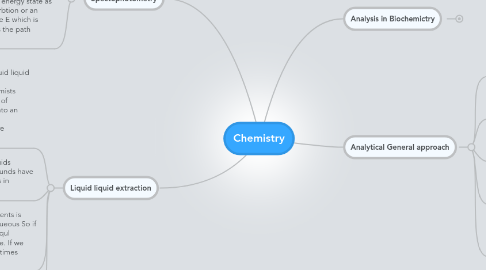Chemistry
af William Keay


1. Spectophotometry
1.1. Helps you identify a compound, choose the wave length to measure for qauntification and analysis
1.2. When a molecule absorbs light an electron is excited to a higher energy state as it returns to gorund state energy is emmited. This gives an abdorbtion or an emmision spectrum. Beer lamberts law A which is the absorbance E which is the molar absorbavitly c which is the concentration and l which is the path length.
2. Liquid liquid extraction
2.1. Organic chemists oftern use liquid liquid extraction to seperate a newly snthesised product. Analytical chemists oftern se it to extract a compound of interest from an aqueous system into an organic solvent. In genral large unionised polar slvents will be more soluble in organic solvents.
2.2. A compound will partition between two immiisicle liquids depending on its soluability in each. If the two compounds have diferrent solubility they will seperate. Similar principles in chromatogrpahy.
2.3. Partition coefficients. The relative solubility of a compound between two solvents is given by its partition or distribution coefficient Kd. it is organic divided by aqueous So if AX has a partition coefficient bettween hexane and water and we shake up equl volumes of solvents then the concentration will be 10 times greater iin hexane. If we shake up 10mls of hexane with 1ml of water the actual amount is approx ten times more.
2.4. So if i wanted to extract a solvent i would use liquid liquid extraction
3. Analysis in Biochemictry
3.1. Thrapeutic Drug Monitoring
3.2. Tablets and medicines eg drugs vitamins
3.2.1. New node
